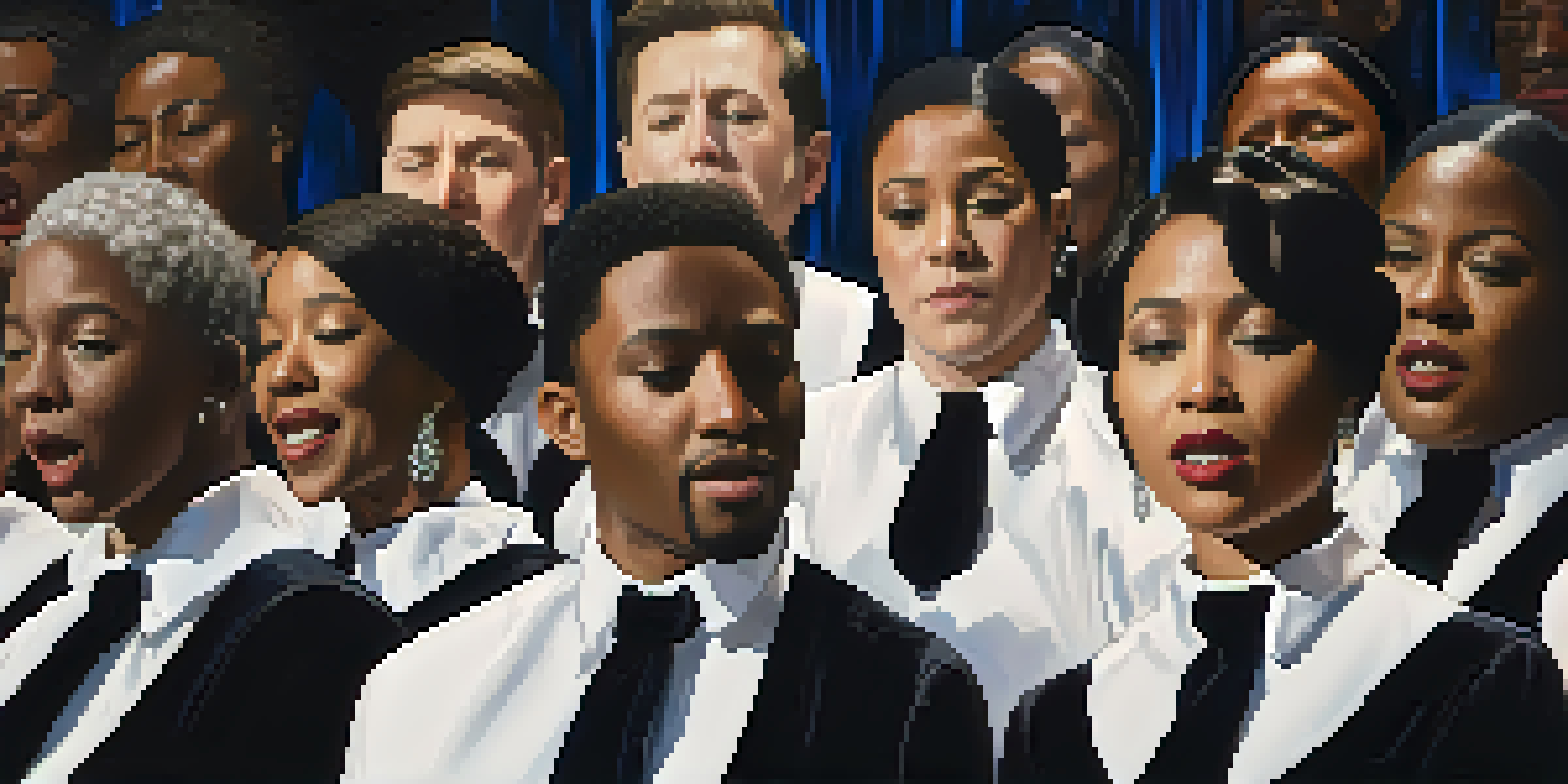Choral Arranging: Crafting Unique Choir Pieces

Understanding the Basics of Choral Arranging
Choral arranging is both an art and a science, requiring a blend of creativity and musical knowledge. At its core, it involves taking a piece of music and transforming it into a version suitable for a choir, considering factors like vocal ranges and harmonies. Understanding the different voice types—soprano, alto, tenor, and bass—is crucial, as each has distinct capabilities and roles within the arrangement.
Music is the shorthand of emotion.
Think of choral arranging like cooking a meal. You start with a recipe (the original piece) and then adapt it based on the ingredients you have (the voices in your choir). Each choir is unique, with its strengths and weaknesses, which means every arrangement should cater to those specific characteristics. The goal is to create a harmonious blend that showcases the choir's collective voice.
Having a solid foundation in music theory can significantly enhance your arranging skills. Concepts like chord progressions, key signatures, and counterpoint are essential tools that help you create richer, more engaging arrangements. By mastering these basics, you’ll be better equipped to experiment and innovate in your choral pieces.
Choosing the Right Piece to Arrange
Selecting the right piece to arrange is a pivotal step in the choral arranging process. Consider the interests and skill levels of your choir members; an engaging piece can motivate and inspire them. Think about the occasion for which you’re arranging—whether it’s a holiday concert or a competitive performance—as this context can guide your choice.

For instance, if you’re preparing for a festive event, opting for a traditional carol might resonate well with both the choir and the audience. On the other hand, arranging a contemporary pop song can create an exciting and fresh experience. It's essential to strike a balance between challenge and accessibility to ensure all choir members can contribute meaningfully.
Choral Arranging Basics Explained
Choral arranging requires understanding voice types and music theory to create harmonious arrangements.
Don’t forget to consider the emotional impact of the piece. A song that tells a story or evokes strong feelings can create a deeper connection with the audience. By choosing the right material, you set the stage for a memorable performance that showcases your choir's unique strengths.
Analyzing the Original Composition
Before diving into the arrangement, it’s crucial to analyze the original composition thoroughly. Listen to various interpretations and pay attention to the song's structure, melody, and harmonies. This analysis helps you identify the essence of the piece, which you’ll want to preserve while adding your personal touch.
The beauty of music is that it connects people. It brings them together and creates a bond that transcends words.
As you dissect the composition, take notes on the sections you find most compelling. Are there certain phrases that stand out? Perhaps a particular harmony that resonates? These elements can serve as focal points in your arrangement, guiding how you build the parts for different voice sections.
Additionally, consider the dynamics and emotional peaks of the piece. Noting where tension builds and where it resolves can help you create a more engaging arrangement. By understanding the original work deeply, you’ll be better equipped to breathe new life into it while honoring its roots.
Developing Vocal Harmony and Texture
One of the most rewarding aspects of choral arranging is crafting vocal harmony and texture. This involves layering different vocal parts to create a rich and immersive sound. Experiment with various harmonies—triads, seventh chords, and even more complex structures—to find what works best for your chosen piece.
Think of each voice part as an ingredient in a recipe. Soprano melodies can serve as the centerpiece, while altos provide depth, tenors add complexity, and basses ground the arrangement. Balancing these elements is key; too much focus on one part can overshadow the others, resulting in a disjointed sound.
Choosing the Right Piece Matters
Selecting a piece that resonates with your choir's skills and the performance context is crucial for success.
Don't shy away from using counterpoint, the interplay between independent melodies, to add interest. This technique can create a dialogue between different voice parts, enhancing the overall texture of the arrangement. By thoughtfully developing vocal harmony, you’ll create a captivating choral experience that resonates with both the singers and the audience.
Incorporating Dynamics and Expression
Once you have your harmonies in place, it's time to focus on dynamics and expression. Dynamics refer to the volume of the music, and they play a crucial role in conveying emotion and drama. Consider where you want your choir to swell to a powerful forte or drop to a delicate piano, creating a sense of ebb and flow throughout the piece.
Incorporating expressive techniques like crescendos, decrescendos, and accents can breathe life into your arrangement. For example, a gradual crescendo can build anticipation before a climactic moment, while a sudden drop in volume can create an intimate atmosphere. These nuances help tell the story of the piece and engage the audience on a deeper level.
Additionally, pay attention to phrasing and articulation. How the choir enunciates the lyrics can change the overall impact of the performance. Encourage your singers to connect emotionally with the music, allowing their interpretations to shine through. This connection can transform a simple arrangement into a captivating experience.
Finalizing Your Choral Arrangement
As you approach the final stages of your choral arrangement, it’s time to refine and polish your work. Review the entire piece for coherence and flow, ensuring that transitions between sections feel natural. This step often involves revisiting earlier decisions and making adjustments based on how the arrangement feels as a whole.
Consider running through the arrangement with your choir to gauge their response. This rehearsal can provide valuable insights into what works and what might need tweaking. Encourage feedback and make note of any sections that may feel particularly challenging or unclear for the singers.
Performing Requires Emotional Connection
A successful choral performance hinges on the choir's ability to convey the piece's emotion and connect with each other.
Finally, put your finishing touches on dynamics, articulation, and any additional embellishments. A well-rounded, cohesive arrangement is what you’re aiming for, one that not only showcases the talents of your choir but also leaves a lasting impression on your audience. With a bit of patience and creativity, your unique choral piece will be ready for the spotlight.
Performing and Sharing Your Arrangement
The moment of truth arrives when it’s time to perform your arrangement. A successful performance is not just about hitting the right notes; it's about conveying the emotion and story behind the piece. Encourage your choir to connect with the music and with each other, fostering a sense of unity that enhances the overall experience.
Consider the performance space as well. Acoustic properties can greatly affect how your arrangement sounds, so adapt your dynamics accordingly. It's beneficial to rehearse in the actual venue if possible, allowing the choir to adjust to the environment and find their best sound.

After the performance, share your arrangement with others! Whether through recordings, sheet music, or social media, showcasing your work can inspire other arrangers and choirs alike. The joy of choral music lies in its community, and sharing your unique piece adds to that rich tapestry.